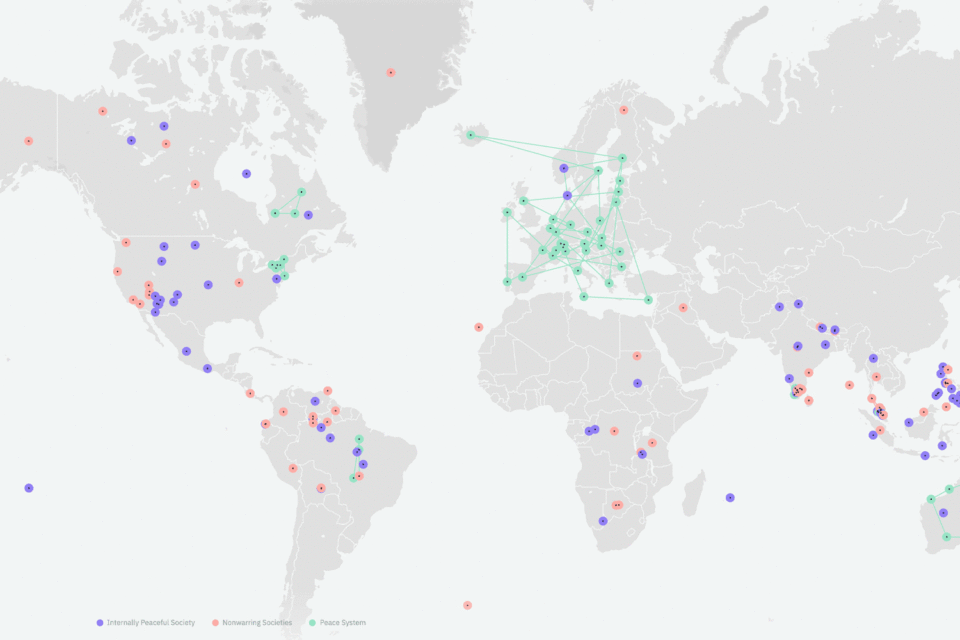Sustaining Peace Project Explores Connection between News Reporting and "Peacefulness" of a Society
March 22, 2021

A team of M.S. in data science students recently collaborated with the Sustaining Peace Project (SPP) at The Earth Institute to investigate the relationship between the language used in online news media and the “peacefulness” of a country.
Jinwoo Jung, Hyuk Joon Kwon, Hojin Lee, Tae Yoon Lim, and Matt Mackenzie‘s capstone project, entitled “The Power of Peace Speech,” addressed challenges at the intersection of data science and social science that illustrate the complex, multifaceted, and ambitious nature of the work that SPP undertakes.
SPP is a multidisciplinary, multimethod initiative that leverages data science, complexity science, and anthropology to develop new ways to understand and promote sustainably “peaceful” societies. The initiative is led by Peter T. Coleman, a professor of psychology and education, director of the Morton Deutsch International Center for Cooperation and Conflict Resolution at Teachers College, executive director of the Advanced Consortium for Cooperation, Conflict, and Complexity at The Earth Institute, and a leading expert in constructive conflict resolution.
At its core, SPP attempts to investigate, quantify, and map an ambiguous state—that of “sustained peace.” “Much of intellectual history has focused on understanding the opposite—states of conflict—in order to develop better approaches to prevention,” Dr. Coleman explains. “The Sustaining Peace Project flips the framework, examining the characteristics and qualities of societies that have successfully sustained peace within and between themselves in order to better understand what we want to promote.”
Through “The Power of Peace Speech” project, the students aimed to explore, identify, and potentially quantify a possible relationship between specific terms in online news media and conditions on the ground. This involved a number of complex data engineering, data analysis, pre-processing, hypothesis testing, and modeling tasks, most notably categorizing societies by state (“peaceful,” “neutral,” “conflicting”), and developing lexicons of terms that would be prevalent in these societies.
The data science students focused on 1.5 million articles from the News on the Web dataset on corpusdata.org, and approached the challenge with both top down and bottom methods. Top down methods involved analysis using predefined lexicons provided by experts. Their bottom up approach used natural language processing methods such as term frequency and deep learning to surface linguistic patterns from the articles themselves. The most successful approach, they found, was a hybrid of the methods. Together, these lists have worked as excellent classifiers of whether the news reports come from “peaceful” or “non-peaceful” places.
The research served as a pilot towards a deeper understanding of the connection between the language used by news media and the peace/conflict state of a particular nation or society. Future work will continue to combine methods and insights from data science and social science to develop new ways of measuring patterns and predicting trends in “peaceful” communities.
SPP develops visualizations, simulations, and other interactive tools to synthesize knowledge across disciplines, sectors, and communities in service of building and sustaining world peace. The initiative aggregates findings from scholarly literature, empirical science, active engagement with “peaceful” communities, and mathematical modeling into a global map that provides information on specific types of “peaceful” societies and “peace systems,” or clusters of societies that sustain “peaceful” relations.
SPP also produces an interactive network tool that visualizes the core factors and processes that influence the likelihood of sustaining peace. More detailed information is also presented in the form of an interactive mathematical model that illustrates how different factors interact to produce different levels of “peacefulness” in society. The model provides a set of 25 factors that can positively or negatively affect social outcomes, and allows users to indicate where on a scale from “none” to “strong” a certain society falls. Adjusting the settings on the factors influences the emergent patterns. The “peacefulness” of a society is indicated by the relative strength of Positive Intergroup Reciprocity over Negative Intergroup Reciprocity.
A 2020 article published by American Psychologist offers an overview of SPP’s work, and a 2021 article in Nature’s Humanities and Social Sciences Communications describes how researchers leveraged complexity science and machine learning to examine the factors that help sustain peace and positive intergroup relationships within peace systems. The authors hypothesized which factors contribute to intergroup peace, such as overarching common identity; positive social interconnectedness; interdependence; non warring values and norms; non-warring myths, rituals, and symbols; and peace leadership, and found that non-warring norms, rituals, and values, in particular, have the greatest relative importance for a “peace system” outcome.
— Karina Alexanyan, Ph.D.